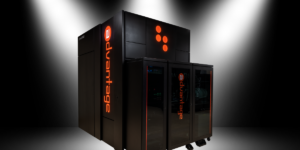USC has been an animating force for computing research since the late 1960s.
With the advent of the USC Information Sciences Institute (ISI) in 1972 and the Department of Computer Science in 1976 (born out of the Ming Hsieh Department of Electrical and Computer Engineering), USC has played a propulsive role in everything from the internet to the Oculus Rift to recent Nobel Prizes.
Here are seven of those victories reimagined as cinemagraphs — still photographs animated by subtle yet remarkable movements.

Cinemagraph: Birth of .Com
1. The Birth of the .com (1983)
While working at ISI, Paul Mockapetris and Jon Postel pioneered the Domain Name System, which introduced the .com, .edu, .gov and .org internet naming standards.
As Wired noted on the 25th anniversary, “Without the Domain Name System, it’s doubtful the internet could have grown and flourished as it has.”
The DNS works like a phone book for the internet, automatically translating text names, which are easy for humans to understand and remember, to numerical addresses that computers need. For example, imagine trying to remember an IP address like “192.0.2.118” instead of simply “usc.edu.”
In a 2009 interview with NPR, Mockapetris said he believed “the first domain name he ever created was ‘isi.edu’ for his employer, the (USC) Information Sciences Institute. That domain name is still in use today.”

Grace Park, B.S. and M.S. ’22 in chemical engineering, re-creates Len Adleman’s famous experiment.
2. The Invention of DNA Computing (1994)
“In a drop of water, a computation took place.”
In 1994, Professor Leonard Adleman, who coined the term “computer virus,” invented DNA computing, which involves performing computations using biological molecules rather than traditional silicon chips.
Adleman — who received the 2002 Turing Award, often called the Nobel Prize of computer science — saw that a computer could be something other than a laptop or machine using electrical impulses. After visiting a USC biology lab in 1993, he recognized that the 0s and 1s of conventional computers could be replaced with the four DNA bases: A, C, G and T. As he later wrote, a “liquid computer” can exist in which interacting molecules perform computations.
As the New York Times noted in 1997: “Currently the world’s most powerful supercomputer sprawls across nearly 150 square meters at the U.S. government’s Sandia National Laboratories in New Mexico. But a DNA computer has the potential to perform the same breakneck-speed computations in a single drop of water.”
“We’ve shown by these computations that biological molecules can be used for distinctly non-biological purposes,” Adleman said in 2002. “They are miraculous little machines. They store energy and information, they cut, paste and copy.”
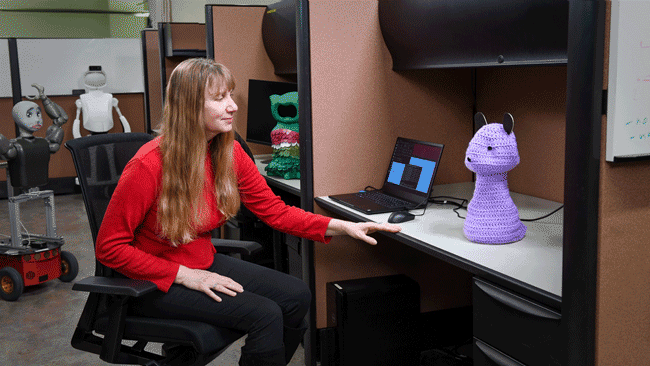
Professor Maja Matarić with Blossom, a cuddly, robot companion to help people with anxiety and depression practice breathing exercises and mindfulness.
3. USC Interaction Lab Pioneers Socially Assistive Robotics (2005)
Named No. 5 by Business Insider as one of the 25 Most Powerful Women Engineers in Tech, Maja Matarić leads the USC Interaction Lab, pioneering the field of socially assistive robotics (SAR).
As defined by Matarić and her then-graduate researcher David Feil-Seifer 17 years ago, socially assistive robotics was “envisioned as the intersection of assistive robotics and social robotics,” a new field that “focuses on providing social support for helping people overcome challenges in health, wellness, education and training.”
Socially assistive robots have been developed for a broad range of user communities, including infants with movement delays, children with autism, stroke patients, people with dementia and Alzheimer’s disease, and otherwise healthy elderly people.
“We want these robots to make the user happier, more capable and better able to help themselves,” said Matarić, the Chan Soon-Shiong Chair and Distinguished Professor of Computer Science, Neuroscience and Pediatrics at USC. “We also want them to help teachers and therapists, not remove their purpose.”
The field has inspired investments from federal funding agencies and technology startups. The assistive robotics market is estimated to reach $25.16 billion by 2028.
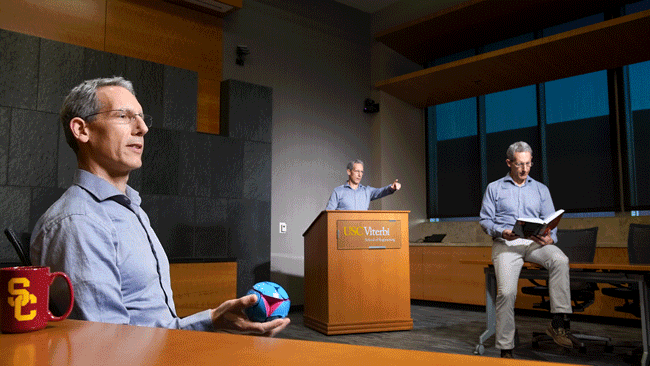
Is the ball red or blue? Is the cat alive or dead? Professor Daniel Lidar, one of the world’s top quantum influencers, demonstrates the idea of superposition.
4. First Operational Quantum Computing System in Academia (2011)
Before Google or NASA got into the game, there was the USC-Lockheed Martin Quantum Computing Center (QCC).
Led by Daniel Lidar, holder of the Viterbi Professorship in Engineering, and ISI’s Robert F. Lucas (now retired), the center launched in 2011. With the world’s first commercial adiabatic quantum processor, the D-Wave One, USC is the only university in the world to host and operate a commercial quantum computing system.
As USC News noted in 2018, quantum computing is “the ultimate disruptive technology…it has the potential to create the best possible investment portfolio, dissolve urban traffic jams and bring drugs to market faster. It can optimize batteries for electric cars, predictions for weather and models for climate change.…Quantum computing can do this, and much more, because it can crunch massive data and variables and do it quickly with advantage over classical computers as problems get bigger.”
Recently, QCC upgraded to D-Wave’s Advantage system, with more than 5,000 qubits, an order of magnitude larger than any other quantum computer. The upgrades will enable QCC to host a new Advantage generation of quantum annealers from D-Wave and will be the first Leap quantum cloud system in the United States. Today, in addition to Professor Lidar — one of the world’s top quantum computing influencers — QCC is led by Research Assistant Professor Federico Spedalieri, as operations director, and Research Associate Professor Stephen Crago, associate director of ISI.
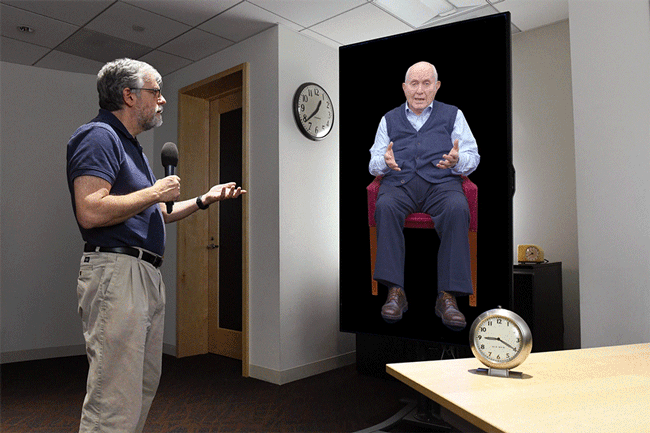
David Traum, a leader at the USC Institute for Creative Technologies (ICT), converses with Pinchas Gutter, a Holocaust survivor, as part of the New Dimensions in Testimony.
5. USC ICT Enables Talking with the Past…in the Future (2015)
New Dimensions in Testimony, a collaboration between the USC Shoah Foundation and the USC Institute for Creative Technologies (ICT), in partnership with Conscience Display, is an initiative to record and display testimony in a way that will continue the dialogue between Holocaust survivors and learners far into the future.
The project uses ICT’s Light Stage technology to record interviews using multiple high-end cameras for high-fidelity playback. The ICT Dialogue Group’s natural language technology allows fluent, open-ended conversation with the recordings. The result is a compelling and emotional interactive experience that enables viewers to ask questions and hear responses in real-time, lifelike conversation — even after the survivors have passed away.
New Dimensions in Testimony debuted in the Illinois Holocaust Museum & Education Center in 2015. Since then, more than 50 survivors and other witnesses have been recorded and presented in dozens of museums around the United States and the world. It remains a powerful application of AI and graphics to preserve the stories and lived experiences of culturally and historically significant figures.
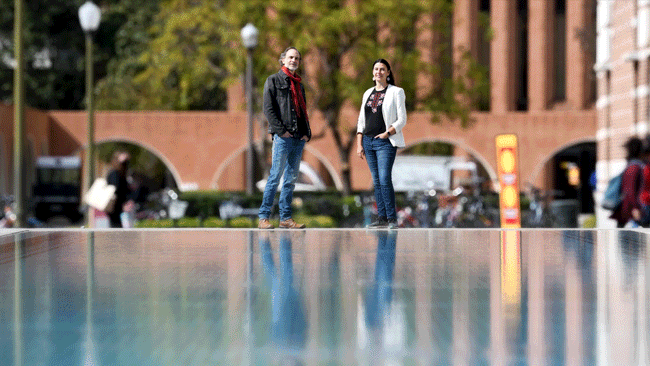
Eric Rice and Bistra Dilkina are co-directors of the Center for AI in Society (CAIS), a remarkable collaboration between the USC Dworak-Peck School of Social Work and the USC Viterbi School of Engineering.
6. Among the First ‘AI for Good’ Centers in Higher Education (2016)
Launched in 2016, the Center for AI in Society (CAIS) became one of the pioneering “AI for Good” centers in the U.S., uniting USC Viterbi and the USC Suzanne Dworak-Peck School of Social Work.
In the past, CAIS used AI to prevent the spread of HIV/AIDS among homeless youth. In fact, a pilot study demonstrated a 40% increase in homeless youth seeking HIV/AIDS testing due to an AI-assisted intervention. In 2019, the technology was also used as part of the largest global deployment of predictive AI to thwart poachers and protect endangered animals.
Today, CAIS fuses AI, social work and engineering in unique ways, such as working with the Los Angeles Homeless Service Authority to address homelessness; battling opioid addiction; mitigating disasters like heat waves, earthquakes and floods; and aiding the mental health of veterans.
CAIS is led by co-directors Eric Rice, a USC Dworak-Peck professor of social work, and Bistra Dilkina, a USC Viterbi associate professor of computer science and the Dr. Allen and Charlotte Ginsburg Early Career Chair.
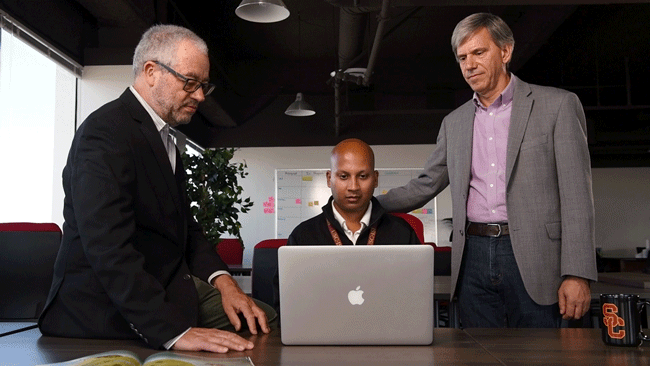
Pedro Szekely, Mayank Kejriwal and Craig Knoblock of the USC Information Sciences Institute (ISI) are at the vanguard of using computer science to fight human trafficking.
7. AI That Fights Modern Slavery (2017)
Beginning in 2017, a team of researchers at ISI led by Pedro Szekely, Mayank Kejriwal and Craig Knoblock created software called DIG that helps investigators scour the internet to identify possible sex traffickers and begin the process of capturing, charging and convicting them.
Law enforcement agencies across the country, including in New York City, have used DIG as well as other software programs spawned by Memex, a Defense Advanced Research Projects Agency (DARPA)-funded program aimed at developing internet search tools to help investigators thwart sex trafficking, among other illegal activities. The specialized software has triggered more than 300 investigations and helped secure 18 felony sex-trafficking convictions, according to Wade Shen, program manager in DARPA’s Information Innovation Office and Memex program leader. It has also helped free several victims.
In 2015, Manhattan District Attorney Cyrus R. Vance Jr. announced that DIG was being used in every human trafficking case brought by the DA’s office. “With technology like Memex,” he said, “we are better able to serve trafficking victims and build strong cases against their traffickers.”
“This is the most rewarding project I’ve ever worked on,” said Szekely. “It’s really made a difference.”
Published on July 28th, 2022
Last updated on August 4th, 2023





